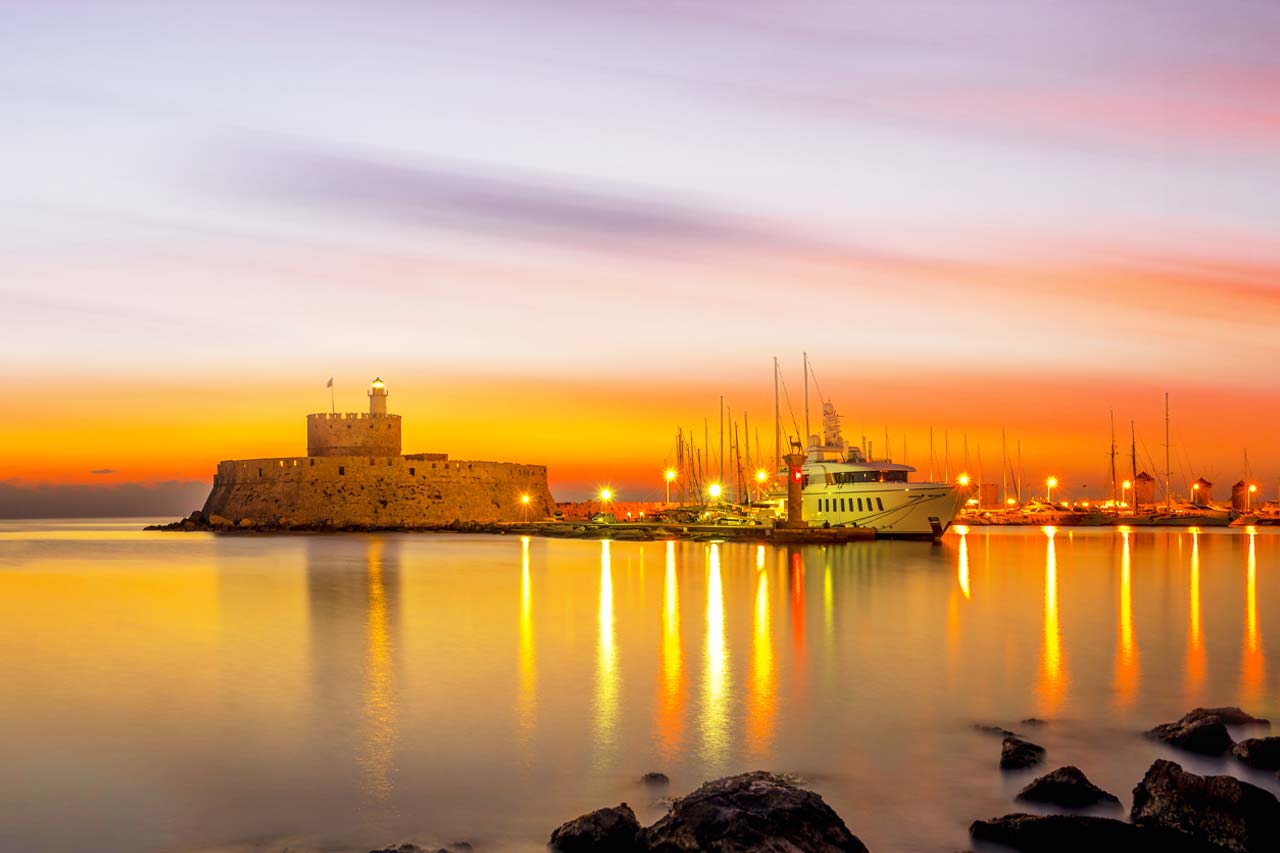If you are looking for a complete Rhodes travel guide, as well as ferry schedules to one of the best tourist destinations in Greece, then you are in the right place.
Rhodes is an enchanting destination in Greece with visitors from all over the world choosing it for their holidays.
According to mythology, Rhodes emerged from the sea at the behest of Zeus and was given as a gift to Apollo.
Steeped in history and culture, the island of Rhodes offers visitors breathtaking scenery, beautiful beaches and a number of historical sites.
Whether you want to enjoy an unforgettable holiday on the island’s beaches or explore its vast history, we can help you plan the perfect trip to Rhodes.
Rhodes tourist information
Rhodes is located in the heart of the Aegean Sea and is a Greek island that offers a combination of rich history, stunning scenery and vibrant culture.
As one of the largest and most popular islands in Greece, Rhodes attracts travellers from all over the world. This is why the ferry schedules to Rhodes are quite frequent.
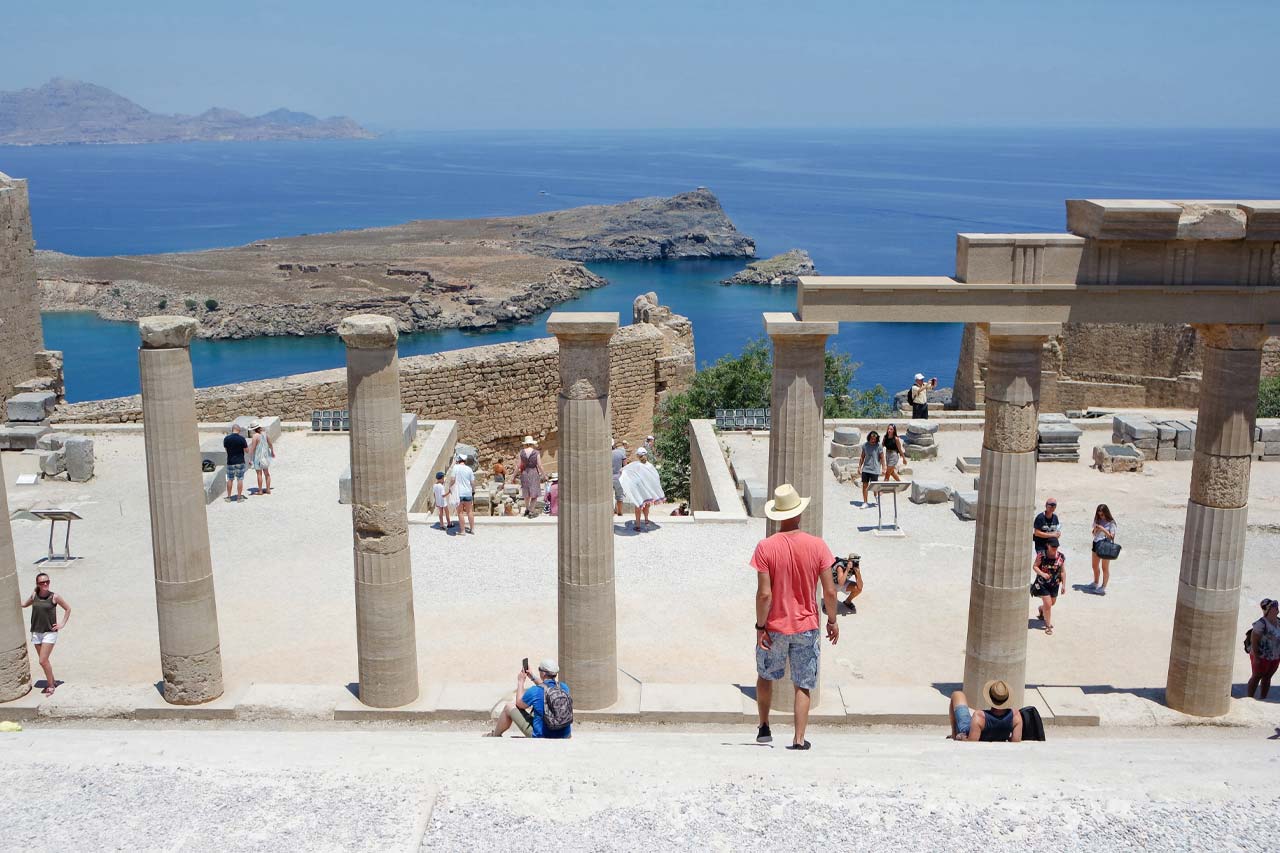
The island has some of the best and sunniest beaches, which will meet your every need.
Prasonisi is a windsurfer’s paradise, while Anthony Quinn Bay offers crystal clear waters for swimming and snorkeling. Watch majestic sunsets at Rhodes’ famous Acropolis or enjoy a leisurely evening stroll along Ellie Beach.
In addition, Rhodes offers a wealth of outdoor activities.
Hike in its lush forests, study history through ancient ruins such as the Temple of Apollo, or take boat cruises to hidden coves and caves.
The Valley of the Butterflies is another unique natural wonder that is known all over the planet. There, thousands of butterflies gather during the summer months.
So, whether you are looking for a historical exploration thousands of years back or relaxing on sunny beaches, Rhodes is sure to impress you.
In the rest of our Rhodes Travel Guide, we’ll look in more detail at all the attractions and experiences you can have on the island.
Rhodes General Information
According to mythology, Rhodes emerged from the sea at the behest of Zeus, who destined it as a gift for the god Apollo.
Another myth claims that the first inhabitants of the island were the Telchines and that the island was named after the daughter of Poseidon and the Sun, Rhodes.
Archaeological evidence suggests that Rhodes was first inhabited during the Neolithic period, i.e. in the 3rd millennium BC.
The historical importance of Rhodes
Rhodes has a rich history going back several thousand years. During the Minoan period (1900-1450 BC), the island flourished and the Achaeans settled in the middle of the 2nd millennium BC. In the 10th century BC, the Dorians arrived and Hercules’ son, Tlepolemos played a crucial role in the founding of the island’s three main cities, namely: Lindos, Camiros and Ialyssos, forming the famous “Doric Exapolis”.
The strategic position of Rhodes at the southeastern end of the Aegean Sea facilitated rapid maritime and commercial development during the 7th and 6th centuries BC.
In addition, the island managed to establish several colonies and its influence extended to several neighboring regions. At that time, when an aristocratic system prevailed, one of the seven sages of antiquity, Cleobulus, ruled as the tyrant of Lindos.
Alliances and independence of Rhodes
Rhodes joined the 1st Athenian Alliance in 478 BC. However, during the Peloponnesian War (431-404 BC) it changed sides and supported the Peloponnesian Alliance with the help of Sparta.
In 411 BC, the three main cities of Rhodes decided to create a new city with a well-planned strategic layout, which was completed in 408 BC. This new city was built on the hill of the Acropolis and became a political, economic and cultural centre for the island.
In 323 BC, Rhodes regained its independence and, during the wars of Alexander the Great’s successors, managed to successfully defend itself against Demetrius of Bessier. The construction of the “Colossus of Rhodes”, one of the Seven Wonders of the Ancient World, commemorates this victory. In the 4th century BC, Rhodes emerged as a leading maritime power in the Aegean Sea, dominating the trade of the eastern Mediterranean.
Roman era and after
During the Roman period, specifically starting from the 2nd century BC, Rhodes remained a commercial and cultural hub and was an early adopter of Christianity. In the turbulent years that followed, Rhodes faced attacks from various powers, including the Persians, the Arabs and the Saracens.
In 1309, the Knights of St. John took control of the island, whose rule marked a great period of development for the island. However, in 1522, Sultan Suleiman the Magnificent conquered Rhodes, the Knights surrendered and the island came under Turkish rule.
During the 19th century, Rhodes, like the rest of Greece, faced challenges from the Ottoman Empire, but was unable to participate in the wider Greek revolution. Rhodes came under Italian control in 1912 during the Italian-Turkish War and later in World War II suffered the hardships of German occupation.
In 1945, the Dodecanese, including Rhodes, were transferred to the Allies and eventually to England. In 1948, Rhodes and the Dodecanese became part of Greece, marking the island’s place in the modern era.
Rhodes Religional and Monuments
Rhodes, known for its rich history, is not only an island of natural beauty but also a treasure trove of religious and historical landmarks. From early-Christian basilicas to Byzantine churches, the island is adorned with monuments that reflect its spiritual and cultural heritage.
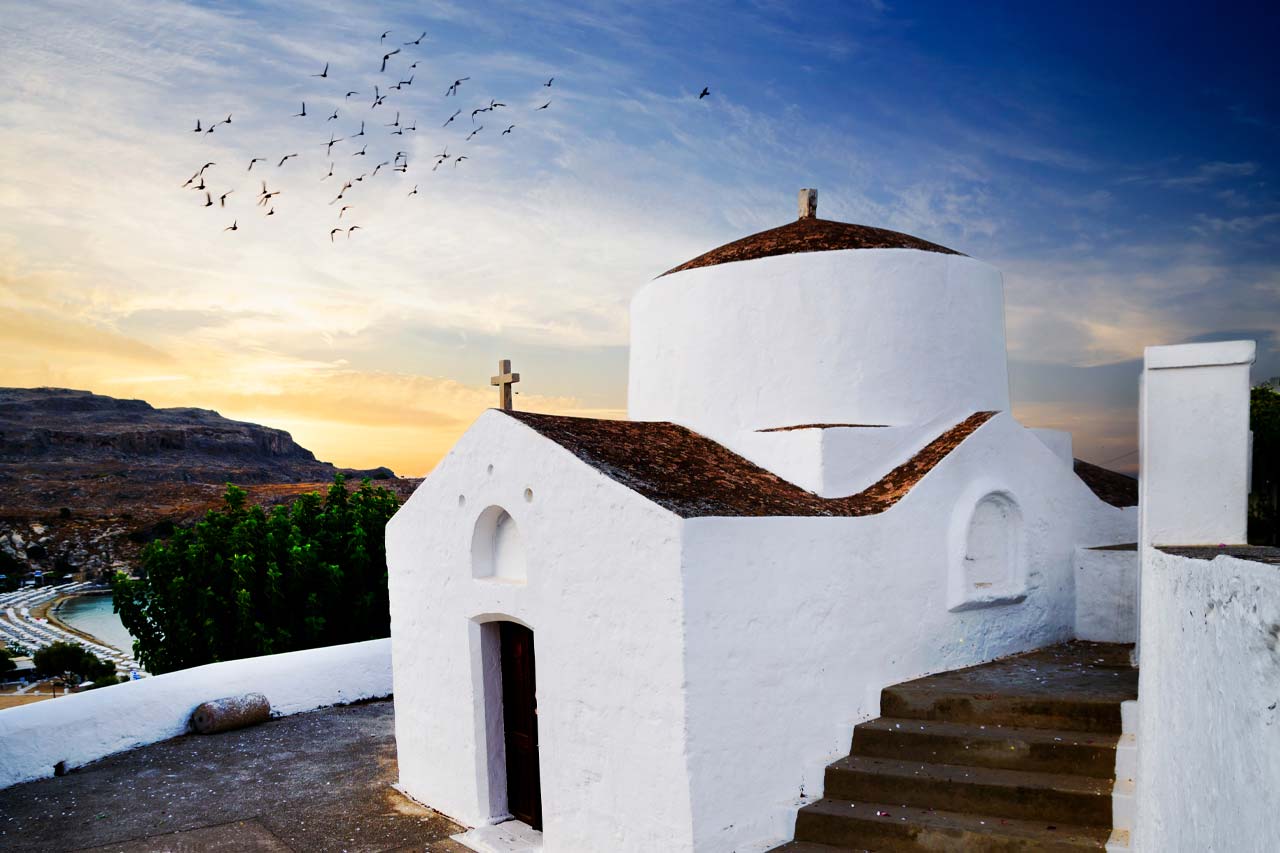
More than 60 early-Christian basilicas have been unearthed across Rhodes, bearing witness to the island’s deep-rooted religious history.
These ancient places of worship offer a glimpse into the island’s early Christian communities and their architectural and artistic expressions. Let’s take a closer look to all Religional and Monuments in our detailed Rhodes Travel Guide bellow.
Rhodes Municipality
- Church of Panayia tou Kastrou (11th century): Originally an inscribed cruciform church, it was later converted into a mosque during the Turkish period. Today, it houses a museum and sculpture gallery.
- Church of Ai-Fanouris: This free-cross plan church was transformed into a mosque under Turkish rule.
- Church of Aghia Triada: A four-conch church with eclectic-style paintings in the western section, it was used as a mosque (Dolapli) during Turkish rule.
- Hourmali Medrese: Originally a four-conch Byzantine Church of St. Mark, it later became a Franciscan monastery and, under the Turks, a mosque and seminary.
Archangelos Municipality
- Church of Archangel: Featuring cross-shaped domes and a cobbled courtyard.
- Church of Panayia Tsambika: This Dodecanese-style church dates back to at least 1760 and boasts cross-shaped domes, a cobbled floor, a fine screen, and imposing icons.
- Church of Aghios Georgios (Malona – early 19th century): A parish church with a 35-meter-high bell tower, showcasing remarkable architectural design.
- Kameiri Monastery (16th century): A Byzantine monastery with traces of frescoes and a cobbled yard.
Atavyros Municipality
- Church of Aghios Ioannis Artamitis: A post-Byzantine church built on the site of an earlier temple, known for its theological and spiritual significance.
- Church of Aghios Panteleimon (Sianna – 1890): A splendid, large church adorned with rich internal and external decoration.
Afantou Municipality
- Church of Aghios Dimitrios (Archipoli): A modern church known for its architectural appeal.
- Church of Panayia Katholiki (Afantou): Built on the ruins of an early Christian basilica and a mid-Byzantine church, it features impressive 14th and 16th-century frescoes.
- Church of Aghios Georgios (Afantou, 1839): Originally a one-aisled basilica, later extended with two side aisles.
Ialysos Municipality
- On the Philerimos Acropolis (Ialysos): Ancient and Byzantine remains coexist, with highlights including the Church of Panayia Philerimou, an early Christian basilica, and the remains of the Byzantine monastery’s catholicon.
- Church of Aghios Georgios Hostos: A single-aisle chapel with 15th-century eclectic wall paintings.
- 14th-century church: A typical Knights’ period church with a vaulted roof and two hexagonal chapels.
- Mediaeval Monastery: Originally constructed by the Knights of the Order of St. John, it served as a two-story building with an internal courtyard, used for various purposes during different periods.
- Via Dolorosa: A re-creation of the Via Dolorosa with bronze sculptures depicting the Stations of the Cross, leading to a magnificent white cross with a panoramic view.
Kallithea Municipality
- Monastery of Aghios Ioannis (Kalythies): A historic monastery with a strong spiritual significance.
- Church of Aghios Nektarios (Kalythies): A contemporary (20th-century) cathedral church located near a large Ottoman fountain.
- Churches of Odigitria and Aghios Georgios (Koskinou): Notable for their tasteful bell towers.
- Church of Aghia Triada (Psinthos): A small single-aisle church adorned with 15th-century wall paintings.
- Church of Genesion tis Theotokou (Psinthos): This magnificent church features a Roman-style doorway and a monument to local heroes.
Kameiros Municipality
- Cathedral Church of Timios Stavros (Apollona): A Dodecanese-style church adorned with superb wall paintings and a cobbled yard.
- Aghios Nikolaos Monastery at Fountoukli (Dimylia – 15th century): Located near one of the island’s purest and most abundant springs, this monastery features a four-alcove chapel with preserved frescoes.
Southern Rhodes Municipality
- Monastery of Panayia Skiadeni (Mesanagros – 17th century): One of the holiest places of worship on Rhodes, known for its resilience despite repeated destruction by pirates.
- Church of Aghios Philemon (Arnitha): A post-Byzantine church, home to relics and a wooden carved screen.
- Church of Agia Eirini (Arnitha): A church built on the site of an early Christian basilica with valuable architectural elements preserved.
- Church of Aghia Anastasia (4km from Apollakia – 4th-6th century): This large early Christian church features a synthronon, communion table, and iconostasis.
- Church of Koimisi tis Theotokou (Dormition) (Asklipio): A post-Byzantine church with 17th-century frescoes.
- Church of Aghia Anastasia (Gennadi): A single-space church with traces of a Knights’ fortress and 17th-century frescoes.
- Church of Eftavimati (Kiotari, Eftavimati area – 5th-6th century): Remains of an early Christian basilica.
- Church of Metamorfosi (Kiotari): This church, built on the site of an early Christian church, showcases various architectural fragments from the vicinity.
- Church of Aghios Isidoros (Istrios – 17th century): A post-Byzantine single-aisle barrel-vaulted church with remarkable wall paintings.
- Church of Aghia Paraskevi (Kattavia – 1825): Known for its large and exquisitely laid cobble floor and a monument to local heroes.
- Monastery of Zoodochou Pigis [Eleimonitria] (Kremasti): A Byzantine monastery constructed using materials from older structures.
- Church of Panayia Plimmyriani (Lachania): Remains of an early Christian basilica with fine mosaics.
- Church of Aghia Eirini (Lachania): A Dodecanese-type church built on the ruins of an early Christian basilica, preserving the baptistery.
- Mesaոagros: This region has a vibrant spiritual history with numerous chapels like Aghios Nikolaos, Aghia Paraskevi, Aghios Georgios, and Aghios Thomas.
- Church of Theotokou (Mesanagros – 13th century): Built on the site of an early Christian basilica from the 6th century, it incorporates architectural and decorative elements from the earlier structure.
Petaloudes Municipality
- Monastery of Panayia Kalopetra (Tholos): Founded in the 1780s, this monastery is said to have been established by Alexandros Ypsilantis, as a token of gratitude for surviving a storm at sea.
- Church of Panayia Katholiki (Kremasti): A magnificent church, a center of worship for the entire Dodecanese.
- Church of Sotiras (Maritsa): Notable for its blind dome and valuable carved wooden chancel screen.
- Holy Asomatos Monastery (Kremasti): The frescoes date back to 1800 AD, and the monastery features a crypt and a holy spring.
- Holy Archistratigos Monastery: Holy Asomatos Monastery: This three-aisle chapel with a dome features a history linked to ancient architectural elements.
- Holy Agios Nikolaos Monastery (Kremasti): An old small monastery, constructed at the end of the 15th century or the beginning of the 16th, located at Kremasti Castle. It was once the location of Greek language lessons.
- Holy Zoodohos Pigi [Eleimonitria] Monastery (Kremasti): Located south of Kremasti village, this monastery, probably from the 19th century, is associated with a holy spring and a font from an older church.
- Holy Agios Georgios Kranis Monastery (Kremasti): This local name is connected to the ancient Greek “Dorian” word “Krana – Krini,” meaning fountain. The monastery is linked to the patron saint of sowing.
- Holy Agios Nikitas Monastery (Kremasti): A charming Byzantine small 15th-century monastery.
From ancient ruins to exquisite post-Byzantine churches, the island of Rhodes is a sanctuary of history and spirituality, where past and present seamlessly coexist.
Explore these religious and monumental sites to uncover the island’s rich cultural tapestry.
Traditional products of Rhodes
Despite the booming tourism industry and the rapid modernization of its service sector, Rhodes has remained deeply rooted in its agricultural traditions and traditional craftsmanship.
The island’s enduring connection with the land and its villages is the driving force behind the production of a wide range of products, many of which are still made in ways that recall the methods of the past.
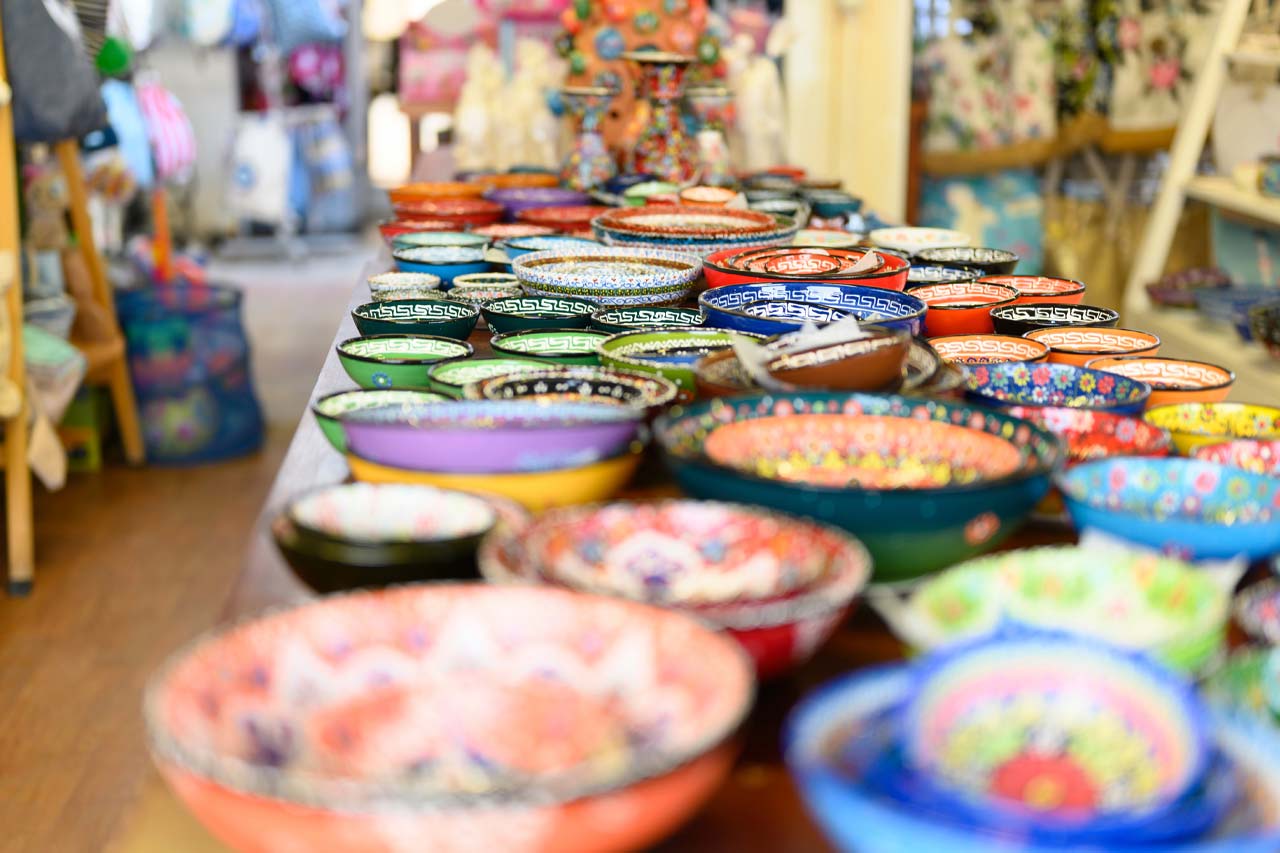
The island of Rhodes has a number of family-run businesses and small workshops that preserve age-old techniques and produce a variety of traditional items.
In the areas of Archangelos and Kamiros, you will find an abundance of family businesses and small units specialising in ceramics.
In picturesque Lindos, local craftsmen create traditional sandals, intricate embroidery, mosaics made of pebbles and carved stone, traditional furniture and textile products.
The village of Empona is famous for its numerous olive mills.
Some of the island’s characteristic products include Souma, a fig-based distillate produced in areas such as Emponas, Siana, Monolithos and Apollo.
Melekounia, traditional wedding sweets made mainly from sesame and honey, are a favorite delicacy of locals and visitors alike.
In addition, you can taste a unique liqueur made from seven aromatic herbs in Filerimo, while local olive oil and honey are produced in Soroni and Apollo, among other places.
Rhodes also offers a delectable selection of wines, champagne and ouzo, highlighting the island’s rich and varied gastronomic heritage.
Historical Landmarks of Rhodes
Rhodes, a captivating island steeped in history, boasts an array of historical landmarks that unveil the stories of ancient civilizations, medieval knights, and a rich cultural tapestry.
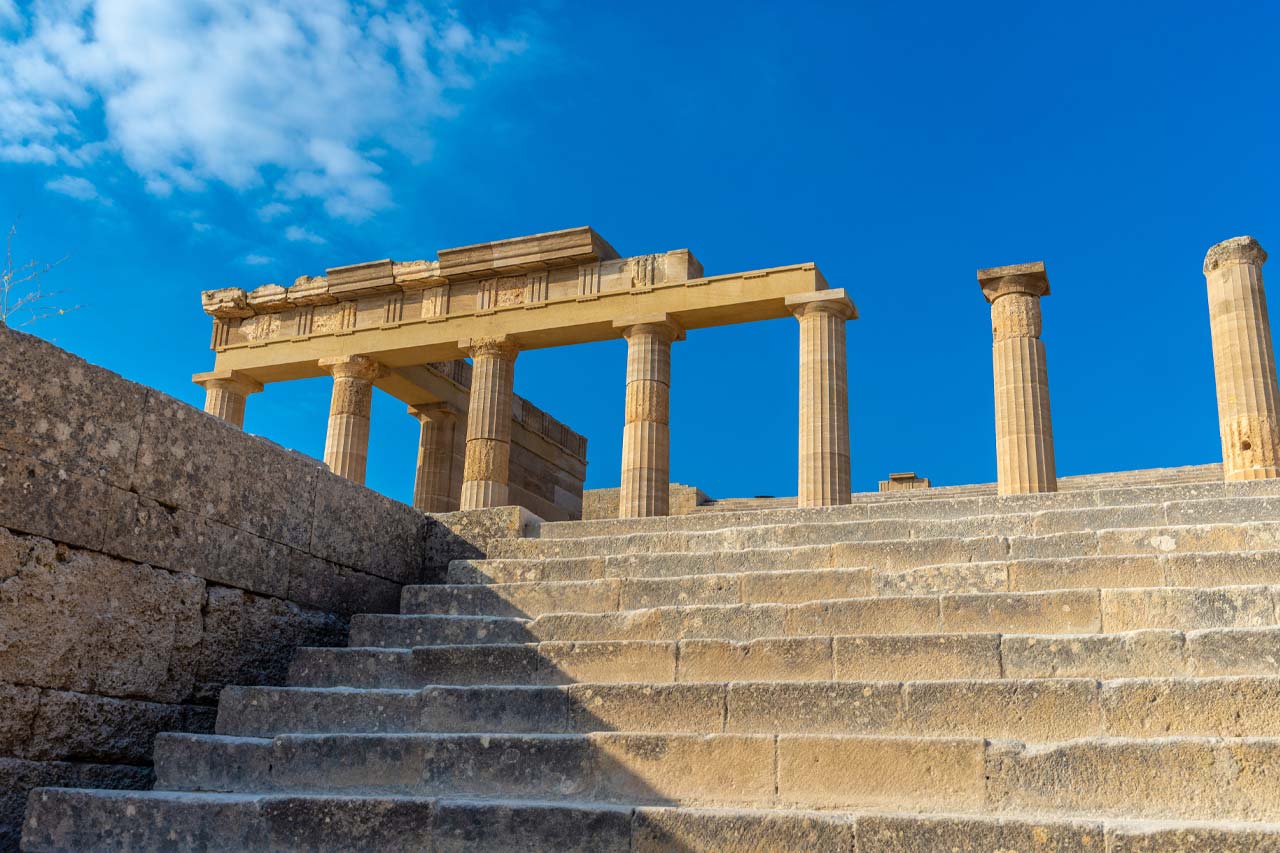
Ancient City (Rhodes)
The ancient city of Rhodes is a testament to urban planning, with the layout adhering to Hippodamus’s philosophies.
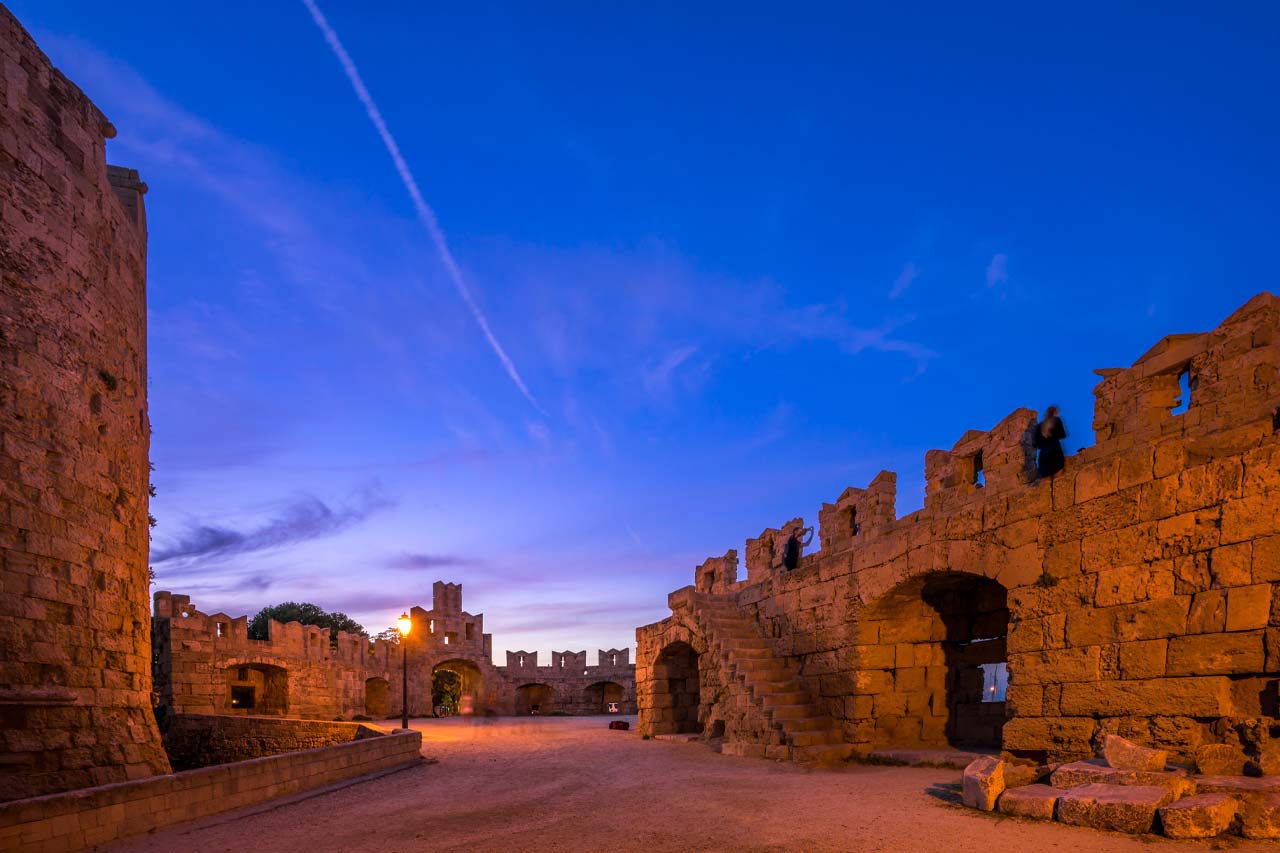
Blocks of buildings, known as insulae, measure 47.70 x 26.50 meters, with streets approximately 5-6 meters wide. The remnants of ancient roads and Hellenistic dwellings from the 3rd and 2nd centuries BC can still be discovered.
Rhodes Acropolis (Monte Smith or Aghios Stephanos Hill)
Explore the remains of the magnificent temples of Athina Polias and Zeus Polieus, the restored old stadium from the 2nd century BC, the rectangular Odeon, the ancient theatre on Diagoridon Avenue, and partially preserved Temple of Apollo Pythias.
Workshops for Casting Bronze Statues (Rhodes, New City)
Recently discovered workshops possibly associated with the creation of the Colossus of Rhodes, one of the ancient world’s wonders. This colossal statue, crafted by sculptor Haris in 282 BC, stood for 12 years before a devastating earthquake in 226 BC brought it down.
Tomb of the Ptolemies (3km from Rhodes Town, on the Rodini elevation)
A massive funerary monument hewn into a natural rock formation in the shape of a Hellenistic construction. The area also houses various Nymphaia (cave shrines), remnants of ancient walls, rock-cut graves, and a Roman aqueduct.
Medieval City (Rhodes)
One of the most significant historic and cultural complexes worldwide, and a UNESCO World Heritage Site.
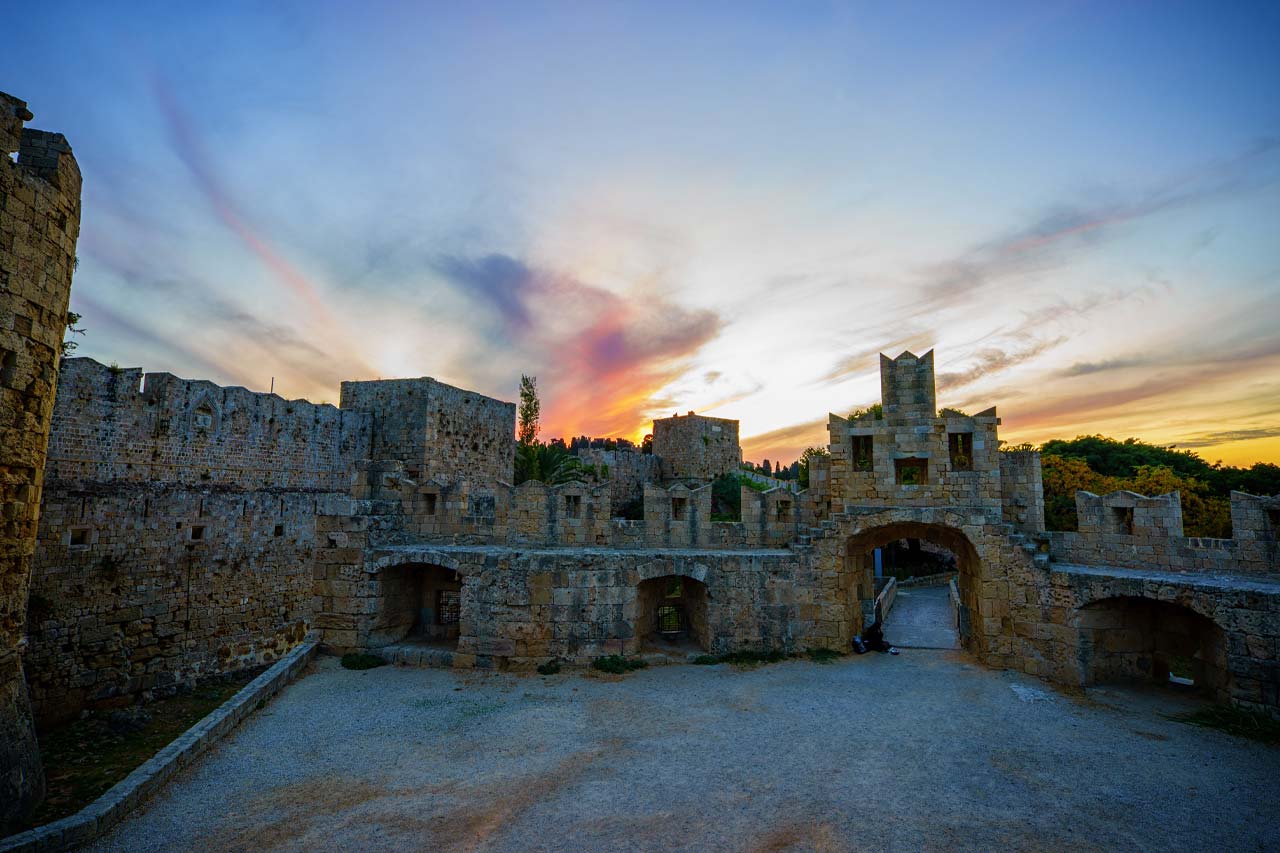
In 1309, the island was sold to the Order of the Knights of St. John of Jerusalem, leading to its renaissance as a major player in the eastern Mediterranean’s affairs.
Street of the Knights
Frozen in time, this street features imposing buildings like the Spanish Inn, the Provencal Inn, the French Inn, the Italian Inn, and more, where knights lived in their respective “tongues.” The cobblestone street tells a tale of medieval grandeur.
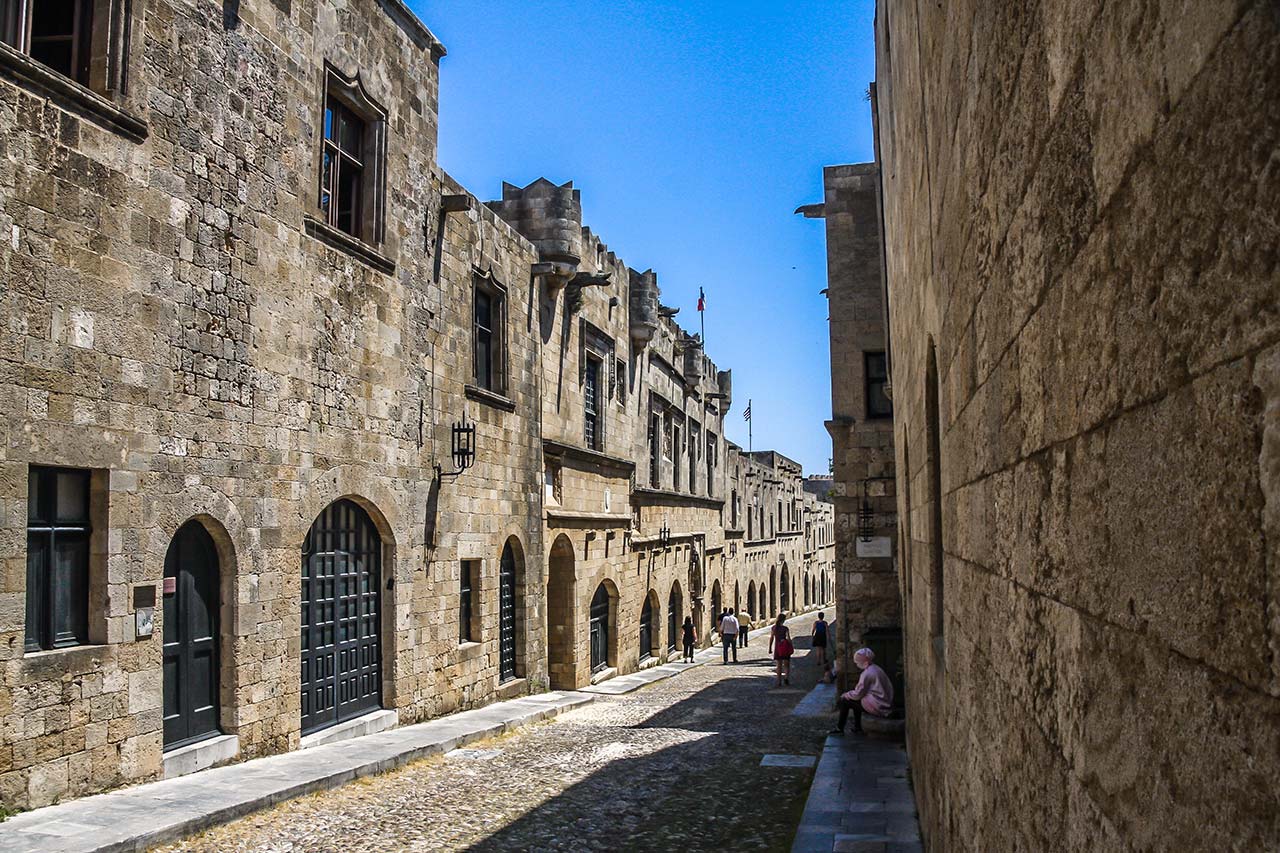
Kastello, or the Palace of the Grand Master (Medieval City)
The most remarkable monument in the Old City, the residence of the Grand Master of the Knights, Helion de Villeneuve (1319-1346).
Although the upper floors collapsed in the mid-19th century, extensive restoration, led by the Italian architect Lojacomo, preserved its historical significance.
Bridge from the Hellenistic Period (Korakonero, beginning of Kallitheas Ave.)
A meticulously restored Hellenistic bridge that harks back to ancient engineering and architecture.
Historical Landmarks of main Rhodes Municipalities
- Municipality of Archangelos: This area holds numerous archaeological finds, including early settlements dating back to 1100 BC. It’s renowned for wine production and shipbuilding skills.
- Municipality of Atavyros: Visit the Temple of Zeus on Atavyros Mountain and the Sanctuary of Artemis, which likely correlates with the Monastery of Aghios Ioannis Artamitis (10th century).
- Municipality of Kallithea: Explore the well-preserved Erimokastro fortress and other historical sites like the Knights’ fort in Koskinou.
- Municipality of Kameiros: Discover the remains of the ancient city of Kameiros, showcasing a Hellenistic city layout and the Temple of Athena. The Fournoi beach boasts ancient carvings.
- Municipality of Lindos: Visit the famed Lindos Acropolis, the Temple of Athena, a theater, the Governor’s building, and more. Explore the historic village, the Tomb of Cleoboulus, and the Acropolis of Lindos.
- Municipality of Southern Rhodes: Archaeological finds, ancient temples, Knights’ forts, and early Christian settlements dot the region, revealing its diverse history.
- Municipality of Petaloudes: Historical highlights include Damatria’s ancient settlement, a temple of Apollo in Theologos, Knights’ forts in Kremasti and Paradeisi, and a treasure trove of archaeological finds across the region.
Museums in Rhodes
Rhodes, with its rich history and cultural heritage, has a large number of museums that will take you back in time. If you too want to explore this rich history, the museums you should visit are:
Main Museums in Rhodes
- Municipal Gallery (Medieval Town, Symi Square): Collections of engravings and paintings as well as exhibitions of well-known painters.
- Nestoridion Melathron (Rhodes, Haritou square): It is the main building of Rhodes Municipal Gallery – Modern Art Museum. It hosts one of the most important collections of Greek art of the 20th century.
- Modern Art Center (Medieval Town, Socrates St., Palio Syssitio Hall): It accommodates the collection with the maps and the gravures of the Municipal Gallery collection since 1400 as well as modern art exhibitions.
- Old Town folk dances Theater: Various cultural events are hosted with emphasis on traditional dances and songs from all over Greece. It can sit seven hundred people.
- Public Library (Medieval Town): It is accommodated in the ground floor of Castellania, a commercial company in the Knights’ rule period. It is a lending library with 50.000 books that cover various fields. Presentations of books and painting exhibitions are organized.
- Rhodes Historical and Archaeological Institute Library (Medieval Town, building of the Knights’ hospital): It cannot be visited by the public. Its content are of historical and archaeological interest.
- Archaeological Museum (Medieval Town): One of the most imposing buildings of the Old Town, it started being built in 1440 by the Great Magistrate De Lastic and it was completed in 1489 by the Great Magistrate D’ Aubusson. It operates as a Museum since 1914. At the center of the building is the central entrance and right above it raises the three-side recess with windows, part of the chapel of the Knights’ Hospital. There are findings that extend from the Mycenaean period till the late Christian period and Knights’ rule: Tombs by ancient Ialisos and ancient Kameiros, mosaics, tombstones, statues, architectural elements etc.
Other Important Museums in Rhodes
- Popular Ornament Collection Museum (Medieval Town): In a building from the Knights’ rule period, it is a small and yet well-arranged and representative collection. Objects representing many arts are exhibited: Ceramics, embroidery, rugs, carpets, wood carved room partitions, traditional costumes and items, tools and furniture.
- Folklore Museum (Apollona): Items used in early history are exhibited (sarcophaguses, parts of columns, column capitals etc.), mill stones, farming tools and everyday items, almost unchanged from Middle Ages.
- Asklipio Museum: A selection of archaeological relics, religious items and folklore memorabilia of functional items for rural life.
- Traditional olive press (Dimilia): The olive press has been transformed to a small museum.
- Konstantakis Museum (Embonas): The family house of an important local poet.
- Folklore Museum (Koskinou): Traditional windmill, one of the many that have been preserved, that has been transformed to a museum worth a visit.
- Popular Art Museum (Kritinia, central road): Impressive in size, very close to the castle.
- Papakonstantis traditional house (Lindos): A collection of traditional plates, traditional costumes and old photographs as well as a Folklore Museum.
- Folklore house (Salakos): Old objects from the locals’ life are exhibited.
- Folklore Museum (Soroni): An old house that has been transformed to a museum, with decorative plates on the walls, traditional furniture and textiles.
Ferry to Rhodes
Rhodes has excellent connectivity through an extensive network of ferry routes.
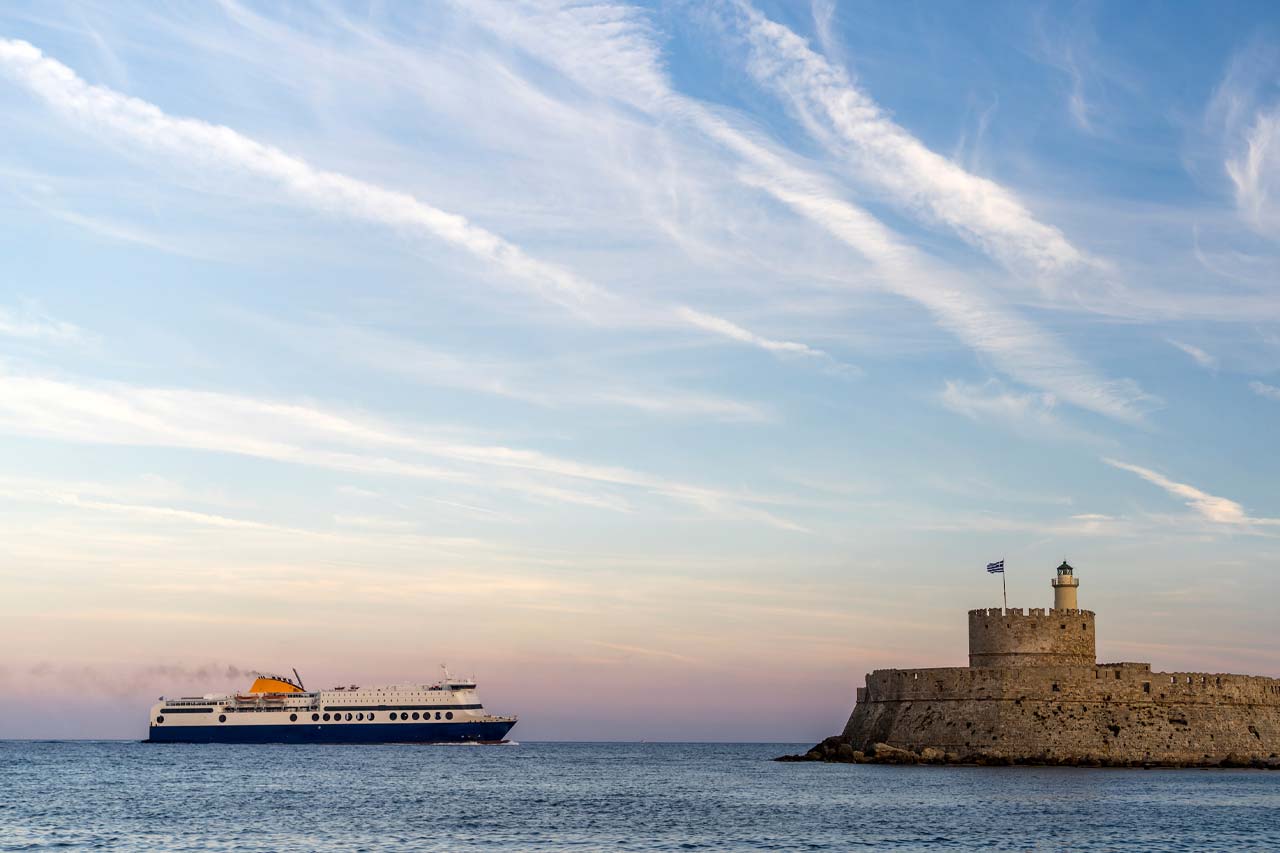
Ferry schedules are quite frequent and connect Rhodes with the capital of Greece as well as with a number of magnificent Greek islands and mainland ports.
The island’s main port, is located in the capital, along with several smaller ports.
If you are interested in booking your trip to Rhodes online, myferry.gr is your best choice.
Frequent ferry routes to and from Rhodes
- Athens
- Piraeus
- Symi
- Kalymnos
- Kos
- Leros
Book online ferry tickets to Rhodes
Securing your ferry tickets to Rhodes has never been easier. If you want to spend an unforgettable holiday in Rhodes, exploring its vast history and cultural heritage, all you have to do is make your booking through our platform.
Myferry.gr is a modern and reliable platform for ferry bookings, which will help you choose the best way to travel to one of the most beautiful islands in the world.
Thanks to our user-friendly ferry booking system and access to a wide range of ferry schedules, our company ensures that you will plan the ideal trip without any hassle and unnecessary expenses.
Discover the beauty and history of this remarkable destination with just a few clicks.
Why book ferry to Rhodes with myferry.gr
Myferry.gr is a reliable and user-friendly platform to book ferry tickets to Rhodes and other Greek destinations.
Here are some reasons why you might consider using myferry.gr for your ferry bookings:
- Extensive Network:gr offers a wide range of ferry routes and destinations across Greece, making it easy to plan your island-hopping adventures.
- User-Friendly Interface: Our website is designed to provide a user-friendly experience, allowing you to easily search for Rhodes ferry schedules, compare options, and complete your booking in just a few steps.
- Customer Support: Myferry.gr will assist you with any inquiries or issues related to Rhodes ferry bookings.
- Affordable Prices: Book cheap ferry to Rhodes or any other destination you prefer.
By booking your ferry to Rhodes with myferry.gr, you can enjoy a hassle-free and efficient travel experience, ensuring that you reach this enchanting island with ease.
We are always at your disposal for more information about your holidays in Rhodes.
We hope that this Rhodes Travel Guide provided you with all the information you were looking for.

